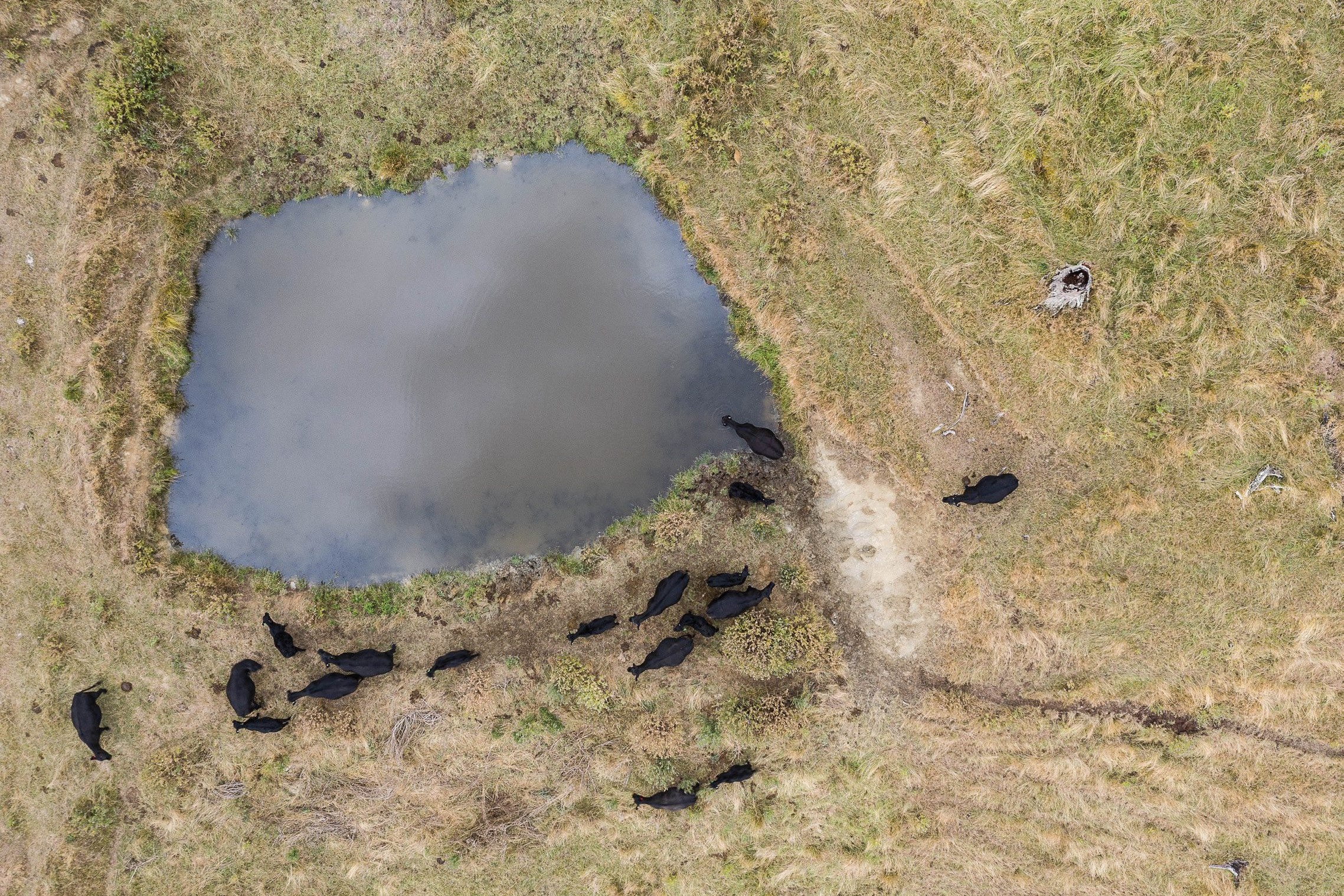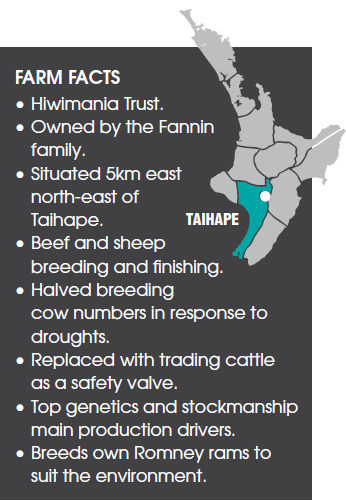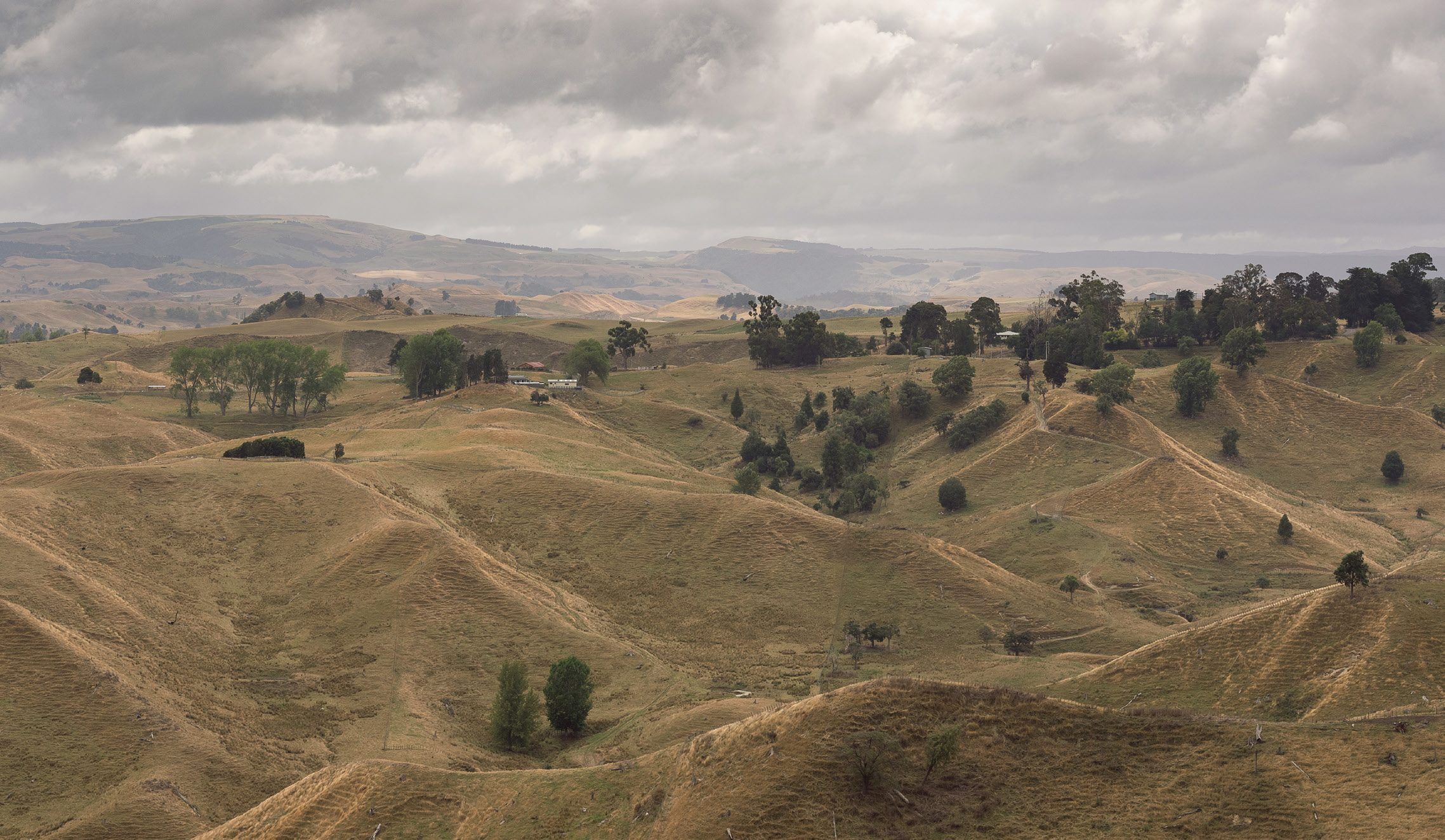Breed ’em and feed ’em
Taihape’s Donald Fannin believes he has matched the right beef genetics with the environment he is farming in. Story by Russell Priest. Photos by Brad Hanson.

While Taihape’s Donald Fannin prides himself in his stockmanship he would be the first to admit without the ability of both his sheep and cattle to perform under pressure he would not be able to achieve the outstanding results he does.
“Livestock performance has a lot to do with matching the right genetics with the environment you’re farming in and I believe I’ve just about got that right,” Donald said.
Joe Fouhy’s Waigroup bulls have been used in the Fannin’s Angus herd for the past 30 years. While they’re not the biggest Angus around they’ve got a lot of guts and their ability to get in calf and deliver a live calf is second to none, according to Donald.
Unfortunately for him, the Fouhy bulls have been sold at auction for the last two years and because he is extremely particular about the bulls he buys he has more often than not had to compete with stud breeders to get the bulls he wants.

“I went to Fouhy’s second sale and the two bulls I liked both went for over $20,000 so I’ve decided to breed a herd of white-head cows and maintain it by criss crossing with Angus and Hereford bulls.”
After leaving school, Donald worked on a lot of stations running Hereford Angus cross females and was always impressed with their performance. He maintains that for the same money he can buy a better quality Hereford bull than an Angus.
Frequent dry summers in recent years and reliance on dams for stock water have forced the Fannins to rethink their cattle policy. This resulted in the cow herd being halved from 200 to 100 last year and trading stock in the form of 60 Hereford Friesian cross weaners at 100kg/head being bought for $450 as bulls late last year and subsequently castrated. These will act as a safety valve although Donald believes he can comfortably winter them on crops (60 R1s and 60 R2s) and kill them at 30 months.
The change of policy meant any cows older than five years were sold so he now has a young herd but doesn’t dismiss increasing cow numbers at some stage. He may also cast his cows for age in future because he believes there is a strong market for this class of stock.
The dry summers left little if any roughage on the hills for the cows to winter on which meant having to carry them through much of that period on crops. This proved to be both labour-intensive and expensive.
The exceptionally growthy spring and early summer during 2020/21 has resulted in a large amount of roughage on the hills giving the cows plenty of work to do over this winter.
“I haven’t had roughage on the hills like this for many years and could have done with the extra 100 cows to control the spring flush.”
Once they’ve cleaned up the hills Donald says they’ll be used to mop up any crop residues left by the younger cattle.
Another recent change has been to delay the start of calving until mid-October for the heifers and November 3 for cows. When weaners were being sold calving used to be in August on saved feed. However, the wet conditions meant the cows churned up the paddocks and sometimes feed ran out. A September calving was tried but this also proved to be too early.
Later calving means feed no longer has to be saved allowing ewes more scope and numbers to increase. Weaner steers are now wintered and either sold in the spring as yearlings or finished. Last year they were sold in November as yearlings for $1150 weighing 330kg.
All 15-month heifers regardless of weight are mated for two cycles starting on January 5 after being wintered on regrowth Sovereign kale for two months supplemented with lucerne balage. Last year the average mating weight was 395kg (range 290-469kg) with this year’s weights 352kg (range 296-406kg) being lighter due to the drought and their younger age (they were the first of the progeny from the later calving policy).
Breeding the best bulls
BVD once spread through the herd with the source suspected of being grazing steers brought in over the summer to maintain pasture quality. All heifers are now vaccinated. Donald is concerned that it may again reappear via the dairy beef cross calves being brought in under the new cattle policy.
A specialist heifer bull with good direct calving ease figures is used to mate the 15-month heifers. Out of 67 heifers mated five were dry this year. The smallest in-calf heifers are sold.
Heifer calving problems are almost non-existent in the Fannin herd and Donald puts this down to the heifers being well grown.
“Too many farmers have trouble getting heifers to rebreed if they’ve had trouble calving.”
In spite of having few calving problems the heifers are kept under close surveillance while they are set stocked for calving.
Donald retains the best five of his Angus bull calves and uses them as yearlings to supplement his older bulls in each of the mating mobs. For example; with a mob of 50 mixed age (MA) cows he might run one MA bull and one yearling, the idea being that the youngsters keep the older bulls sexually motivated.
Bull-out date for the mixed age cows is January 20. Bulls are run with the cows for two cycles. After weaning in May the cows are mobbed up and start their job of cleaning up pastures ready for the spring.
Any dry, wet dry or assisted heifers and cows are culled along with their female progeny.
Bull selection for Donald involves studying catalogues of bull sales he’s likely to attend and sorting out those animals with the required genetic credentials. These include high maternal indexes with above average EBVs and a particular focus on direct and maternal calving ease.
Once at the sales he focuses on those animals he’s pre-selected from the catalogues looking at soundness, conformation and type. He prefers well-muscled animals with a moderate frame avoiding those that are excessively tall and long.
Sheep performance
The Fannins sheep enterprise is based on the same genetic principles (performance under pressure) as their cattle. The performance of the sheep flock in recent years based on Forbes Cameron genetics is impressive. After a severe drought in 2019/20 the MA ewes docked 156% (2019 – 161%) and the ewe hoggets which all go to the ram regardless of weight docked 71% (2019 – 61%).
The small SIL recorded Romney stud’s MA ewes docked 162% for 2020 (ewe hoggets – 89%) and 163% for 2019 (ewe hoggets – 74%).
A feature of the Fannin’s ewe flock is its low embryonic loss (under 20%) and dry rate at about 2% with the rams being out for two cycles.
“We try to flush our ewes but because of the droughts in recent years we haven’t been able to but it seems to make very little difference to conception rates anyway.”
Lighter ewes at ewe culling are given preferential treatment over the summer to improve their condition score for mating. All stud and commercial ewes go through a Hecton dagger and are checked for defects involving the udder, mouth, wool, face cover and feet. Any ewes failing are either culled or go into the B flock as do any that are excessively daggy. All dry and wet dry ewes are culled.
No ewes are cast-for-age being kept in the flock until their teeth and/or condition indicate they will not last another year.
“The old ewes are our best ewes because they have stood the test of time so by keeping them as long as possible we’re breeding longevity into the flock.”
He says the Cameron genetic-based lambs seem to finish easily without too much feed and they’re very hardy.
Most lambs (males are all cryptorchids) are finished on either Sovereign kale or stands of plantain and clover although weeds are a problem in the latter so stands only last about four years. Growth rates of up to 350g/day have been recorded on the latter while this figure is 400g/day on the kale.
Donald says being able to finish all their lambs helps to justify the expense of growing crops.
He tries to get as many lambs away from their mothers as quickly as possible. He mates his 848 B-flock ewes early (mid- March) to Andy Guy’s Suftex rams and gives each a drench capsule to rid them of any worms which may affect milk production. Last year these ewes docked 158% with 70% of the lambs being killed off mum at weaning (before Xmas) in two drafts averaging 17.9kg and 17kg. These together with a weaning draft of single Romney male lambs saw 600 lambs killed before Xmas at 17.9kg and a further 500 killed after Xmas at 17.2kg.
Lambs are killed throughout the summer with most of them gone by mid-April. These are processed on the same day of transport at Silver Fern Farms’ plants at either Waitotara or Takapau.
Ram-out date for the 1264 MA Romney ewes is now April 1 (it used to be April 20). Getting more milk lambs away earlier is the reason Donald has brought the mating date forward. This has largely been made possible by delaying the calving date giving the sheep a greater opportunity to express their genetics.
Hogget mating begins on May 12 using the same Suftex rams used to mate the B-flock ewes at a ratio of one ram to 28 hoggets. “I like to use plenty of rams for hogget mating however in spite of scanning 110% we have disappointing docking percentages.”
Neospora and lepto have both been identified as causing a disturbing number of abortions in the hoggets. In some years, dry hoggets are sold depending upon the requirement for flock replacements.
Lambing hoggets occupy a sheltered basin at the back of the farm where they remain undisturbed. Single bearing ewes lamb on the steeper, more exposed paddocks with twin bearing ewes occupying more sheltered ones. Ewes scanned with triplets are lambed separately however the jury is out on this practice.
“We tried lambing then shedding them on to saved stands of plantain/clover however there appeared to be a lot of mismothering.”
Rams are out with ewes and hoggets for two cycles only with late-lambing ewes being identified by the scanner and lambed separately. Hoggets are weaned between Xmas and New Year and MA Romneys on January 10.
All ewes and remaining lambs are shorn at the end of January and the ewes again in mid-June.
The Fannins run a small SIL recorded Romney flock (prefix Hiwi) of about 200 ewes from which they breed their own rams and also sell about 50 2th rams to clients each year. The stud was established over 100 years ago and in recent years the main focus has been on improving its facial eczema tolerance.
When selecting rams for both stud and commercial use Donald likes them to have a well-balanced maternal worth index with a high breeding value for early growth. He places a lot of emphasis on structural soundness, conformation and breed type and believes not enough emphasis is being placed on these criteria nowadays and too much on genetic information.
Suftex rams are selected on soundness, constitution and the terminal worth index.
Donald is not a fan of rotational grazing, mainly because the farm pugs badly.
The only intensive period during which this practice is carried out is over mating when mobs are shifted regularly although during the recent droughts Donald has preferred to leave the mobs set stocked. All animals are generally set stock over the winter with young cattle and cows going onto crops for the latter part of winter and early spring.

Cropping and finishing
The Fannins rely heavily on crops both for lamb finishing, lifting the weight of tail-end ewe lambs for mating and wintering cattle. For 20 years 30ha of Sovereign kale has been sown in the spring. This area is likely to be reduced now that calving is later. Crops are sown with fertiliser tailor-made for each paddock by Mainland Minerals North Island franchisee Hamish Cameron.
Finishing lambs defoliate the light stemmed kale to a low level beating the white butterfly caterpillar to the leaves before the crop is shut up and fertilised with 100kg urea as winter feed for cattle. The regrowth produces about 8000kg/ha which is break fed and supplemented with lucerne balage. Wrapped bales are strategically placed across the kale paddock before winter and self-fed in circular feeders to R1 heifers and steers from mid-July to September.
“There appears to be far less wastage on lower yielding crops like Sovereign when fed to cattle than those higher yielding ones.”
Taking the cattle off pastures avoids pugging damage and allows the grass to come away in readiness for ewe/hogget lambing. Cleancrop kale has been planted this year to deal with weeds like fathen that normally require post-emergent spraying. Some years green feed oats and Hunter forage brassica are also sown.
A 9ha lucerne stand yielding about 200, 10-bale-equivalent round bales (two cuts) treated with Prillcote inoculant to improve its quality is used to supplement mainly cattle during the winter.
“Cattle love it so much they climb over one another to get to it. I think they could be finished on it.”
Hill cropping has been used in the recent past to grow lamb-finishing and winter feed however this practice has been discontinued because Donald believes it is not sustainable.
Sitting at an altitude of between 650-730m asl and covered in pockets of native bush and macrocarpa stands the farm is exposed to the weather from all directions. The predominant wind is a westerly and brings most of the rain while northerlies are quite common but dry. Falls of snow (7-10cm) are not uncommon and can remain for several days with the heaviest fall of 1m at the house laying around for two weeks.
The farm lies on a watershed which may explain why there is little natural water so dams capturing runoff are the main source of stock water.
About 15% of the farm can be tractor cultivated while the rest is medium-to-steep hills. Soils are predominantly of sedimentary origin (siltstone, mudstone and compacted sand stone) with the latter two preventing water from moving through the soil profile creating drainage problems and significant stock management problems during the winter.
Typically, the sedimentary soils are deficient in sulphur while the phosphate levels on the hill soils range from 12-15. PHs are mostly in the mid-to-late 5 range. Lime flour mixes applied by helicopter or plane in fine particle form involving trace elements, minerals, sulphur and phosphate are used to address the farm’s fertiliser requirements. Ag lime and solid fertilisers are also used strategically when required.
Established pastures get lime at 1T/ha every third year plus 80kg/ha of a blend of lime flour, DAP, elemental sulphur, urea and potassium chloride.
Young grass paddocks get 200kg/ha Cropmaster 20.
Brassica crops get 350-400kg/ha of a blend of DAP 13S and potassium chloride.




